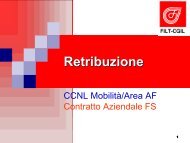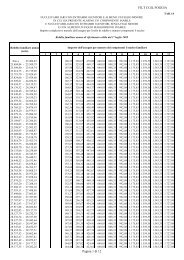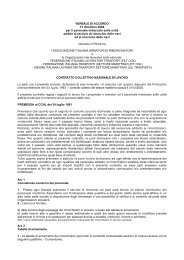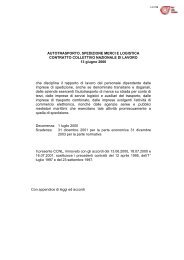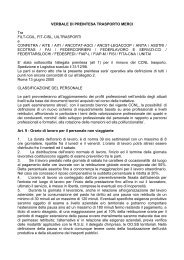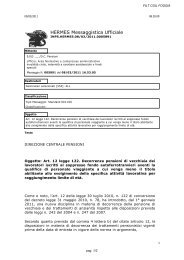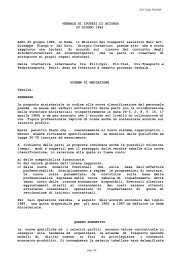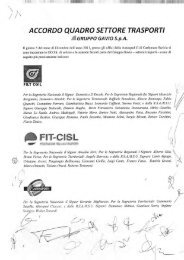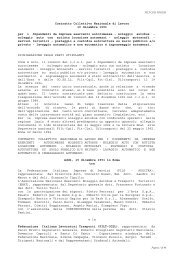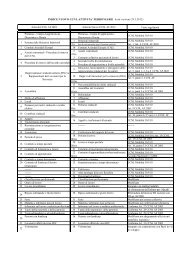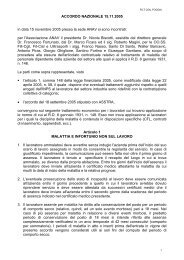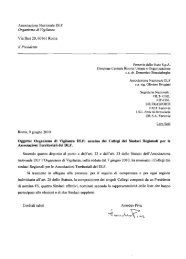Outlook for Air Transport to the Year 2025 - FILT CGIL Foggia
Outlook for Air Transport to the Year 2025 - FILT CGIL Foggia
Outlook for Air Transport to the Year 2025 - FILT CGIL Foggia
- No tags were found...
Create successful ePaper yourself
Turn your PDF publications into a flip-book with our unique Google optimized e-Paper software.
Chapter 2. <strong>Air</strong> <strong>Transport</strong> Trends and Challenges 13Table 2-3. Productivity of international scheduled airlines — World (1965–2005)(ICAO Contracting States)Average levelsProductivity measure 1965 1975 1985 1995 2005<strong>Air</strong>craft productivity<strong>Air</strong>craft load fac<strong>to</strong>r (per cent) 52 50 58 60 63<strong>Air</strong>craft speed (km/h) 469 600 635 647 674<strong>Air</strong>craft utilization (hours per aircraft per year) 1 678 2 064 2 179 2 790 3 556Labour productivityTKP per employee (thousands) 43 82 144 261 397Fuel productivityTKP per litre of fuel (index) 100 123 187 217 277Note.— Excluding operations of airlines registered in <strong>the</strong> CIS.Source: ICAORELATIONSHIP BETWEEN PRODUCTIVITY, PRICESAND FINANCIAL PERFORMANCE21. Having estimated <strong>the</strong> improvement in productivity per<strong>for</strong>mance achieved by <strong>the</strong> airline industry, <strong>the</strong>questions of how <strong>the</strong> improved productivity was used and who received <strong>the</strong> benefits can be addressed. Byreducing <strong>the</strong> quantities of inputs required <strong>to</strong> produce a unit of output, productivity growth has <strong>the</strong> effect ofreducing <strong>the</strong> cost per unit of output. These cost reductions may be used ei<strong>the</strong>r <strong>to</strong> reduce real fares and rates paidby passengers and shippers or <strong>to</strong> provide airlines with improved financial results.22. Changes in <strong>the</strong> real prices paid <strong>for</strong> inputs (e.g. labour and fuel) purchased by <strong>the</strong> airlines are also reflectedin <strong>the</strong> cost per unit of output, and hence in real fares and rates and in financial per<strong>for</strong>mance. The price trends oftwo of <strong>the</strong> most important inputs, labour and jet fuel, are indicated in Figure 2-8, which also shows <strong>the</strong> trend in<strong>the</strong> Consumer Price Index (CPI). International Monetary Fund (IMF) indices <strong>for</strong> industrial countries are used <strong>for</strong><strong>the</strong> labour price and <strong>the</strong> CPI. The importance of labour cost in <strong>the</strong> <strong>to</strong>tal cost structure of airlines and <strong>the</strong> high rateof increase in wage rates suggested in <strong>the</strong> figure have <strong>to</strong>ge<strong>the</strong>r acted as a powerful incentive <strong>for</strong> <strong>the</strong> improvementin labour productivity observed in Figure 2-7. Fuel is ano<strong>the</strong>r key item on <strong>the</strong> expense side of <strong>the</strong> accounts. Theimpact on expenses of <strong>the</strong> very large fuel price increases in 1973–74 and 1979–80 was partly reversed by <strong>the</strong>price declines in 1985. Fur<strong>the</strong>r hikes in jet fuel prices occurred in 1990, 1996 and 2000 when <strong>the</strong> average annualprice in U.S. dollars reached 85 cents per gallon. Due <strong>to</strong> a contraction in demand, <strong>the</strong> jet fuel price softened <strong>to</strong> 69cents on average in 2002 but has since increased substantially <strong>to</strong> reach an average of 171 cents in 2005 increasing<strong>the</strong> pressure on airline operating costs. As a result, <strong>the</strong> share of fuel and oil costs in <strong>to</strong>tal operating costs ofscheduled airlines climbed <strong>to</strong> 22 per cent in 2005 compared <strong>to</strong> only 10 <strong>to</strong> 15 per cent during <strong>the</strong> 1990s.23. The trends in productivity, input prices, yields (i.e. fares and rates), and financial per<strong>for</strong>mance aresummarized in Figure 2-9. A log scale is used so that <strong>the</strong> slopes of <strong>the</strong> trend lines represent percentage changes.The productivity measure is <strong>the</strong> overall index referred <strong>to</strong> above. An overall input price index has also beendeveloped from individual input prices. Input prices and yields are expressed in real terms (i.e. after removing <strong>the</strong>impact of general inflation). Financial per<strong>for</strong>mance is represented by <strong>the</strong> ratio of revenues <strong>to</strong> expenses, whereexpenses are defined <strong>to</strong> exclude taxes and interest.




